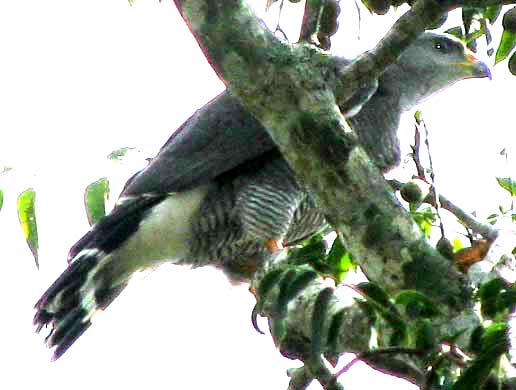Excerpts from Jim Conrad's
Naturalist Newsletter
from the December 6, 2009 Newsletter issued from Hacienda Chichen Resort beside Chichén Itzá Ruins, central Yucatán, MÉXICO; limestone bedrock, elevation ~39m (~128ft), ~N20.676°, ~W88.569°
GRAY HAWK
For several days in a row I heard a sharp, whistled and rather loud WHEEE-eu repeated several times from the big Cedro above the church, I'd step out and there'd be a hawk perched there. You can see him below:

That's an adult Gray Hawk, BUTEO NITIDUS*, along with the Roadside Hawk, Buteo magnirostris, probably the most commonly seen roadside hawks in this part of the world. You can review the Roadside's appearance here.
In poor light they look fairly similar, both showing fine, horizontally barred underparts and strikingly barred tails. However, in good light you see that the adult Gray Hawk is indeed gray while the Roadside Hawk is brownish. Also the Gray's underparts are more finely barred. With juveniles it gets harder, for young Grays are brownish.
This hawk should be in your North American bird field guide, for it extends into Texas's southern tip and during the summer expands northward into Arizona. It's found throughout Mexico except in the highlands and northern deserts, and makes it as far south as northern Argentina. This is one of the Neotropic's best-known hawks, having a penchant for perching conspicuously on electrical poles and roadside trees.
After a few days of daily visits, suddenly he quit coming completely. A lot of birds are like this, forming daily habits that are carried out like clockwork, but which last only a few days. You can see why this would be so: Habitual visits teach one what to be prepared for and where the food is likely to be, but sticking to the routine for too long exhausts the food along your route, and informs those who may want to eat YOU when and where to be watching for you.
from the March 27, 2011 Newsletter issued from Hacienda Chichen Resort beside Chichén Itzá Ruins, central Yucatán, MÉXICO; limestone bedrock, elevation ~39m (~128ft), ~N20.676°, ~W88.569°
GRAY HAWK BEING BROWN
Probably the most commonly occurring hawk in our area is the Gray Hawk, with Roadside Hawks being fairly common, too. Adult Gray Hawks are Gray, and Roadside Hawks are brownish, so it sounds like an easy deal. However, juvenile Gray Hawks are brownish, so whenever you see a brownish hawk you have to look closely. A brown one -- front and back views -- is shown below:

That's a juvenile Gray, most easily distinguished from brown Roadside Hawks by its whitish face. Roadsides have pale eyebrows, but not such extensively pale "cheeks." Also, barring on the bellies of both juvenile and adult Roadside Hawks is horizontal, while on juvenile Grays it's indistinctly vertical.
You can compare the above picture with our brown Roadside Hawk showing nice horizontal belly-barring at www.backyardnature.net/yucatan/roadside.htm.
By the way, if our Gray Hawk atop the power line looks especially small, one reason may be that Grays are a small species. The North's Red-tailed Hawk has a wingspread of 48 inches, while the Gray's wingspread is only 35.
from the April 3, 2011 Newsletter issued from Hacienda Chichen Resort beside Chichén Itzá Ruins, central Yucatán, MÉXICO; limestone bedrock, elevation ~39m (~128ft), ~N20.676°, ~W88.569°
GRAY HAWK PLUMAGE TRANSITION
Just last week (see above) we saw that the Gray Hawk's immature plumage is brown, and that its breast streaks are vertical instead of horizontal as in the adult. This week I got another picture of an immature Gray Hawk, this time showing the breast with some feathers exhibiting vertical streaking, while other feathers are horizontally streaked -- a transition stage. That's the picture below:
